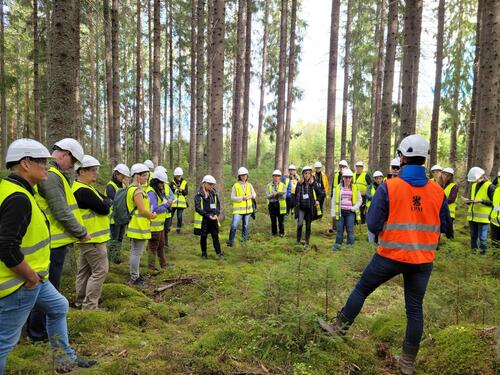
By Alex Weyerhaeuser, Yale School of the Environment, M.E.M ’23 and TFD Communications Associate
If walls could talk, they might lament the extractive and damaging practices that went into their resource-intensive construction; they might plead for the building sector to consider seriously the opportunity to address climate change within the built environment; and the walls that housed The Forests Dialogue (TFD) field dialogue on Climate Positive Forest Products (CPFP) in Helsinki, Finland from 12-15 September 2022, would have a diversity of perspectives to share from the convergence of experts, practitioners, and stakeholders from many parts of the forest products supply chain who came together from all over the world to discuss decarbonization within the building sector.
The meeting in Finland merged resources and expertise from Yale, specifically the Yale School of the Environment (YSE), The Forest School (TFS), TFD, and The Yale School of Architecture (YSoA), as well as a broader network of global stakeholders. This was the second TFD multi-stakeholder dialogue on the topic of CPFP; TFD convened a first “scoping” dialogue remotely in collaboration with the Climate Smart Forest Economy Program (CSFEP) in May 2021 that brought together over 60 stakeholders from NGOs, timber and manufacturing companies, government entities, academic institutions, and construction and architecture firms to “share current activities, agree on knowledge gaps, identify areas of disagreement, and build collaboration to align future actions.” According to TFD, the challenge is clear: the building sector currently accounts for approximately 39% of global greenhouse gas emissions, a statistic that will increase dangerously and dramatically with the world’s growing population and subsequent exponential need for building stock.
One potential solution—“mass timber”—is a relatively new type of wood building material configuration that binds together smaller pieces of wood to form very large panels and could provide a strong and stable alternative to steel or concrete for larger-scale construction projects. Not only does wood use in the building sector have the potential to displace more emissions-intensive materials while storing carbon in its physical structure, but using smaller pieces of wood to create large wood panels can be less extractive to forests and can play a vital role in sustainable forest management practices.
But “fracture lines” and disagreements among key actors could delay and/or divert action from supporting climate-positive products if stakeholders with varying expertise and viewpoints are not brought into the conversation first. TFD Steering Committee member and dialogue co-chair Ana Bastos stressed that because mass timber is a possible solution to decarbonization and increased efficiency within the building sector, a variety of stakeholders need to join the discussion in areas related to “global coordination and coalition for advocacy building; assessment of the impacts associated with accelerated adoption of mass timber production and associated climate change mitigation strategies; research and development for growing more wood in forests; better use of wood in different applications; and increased conversion efficiency at the industrial facilities.”
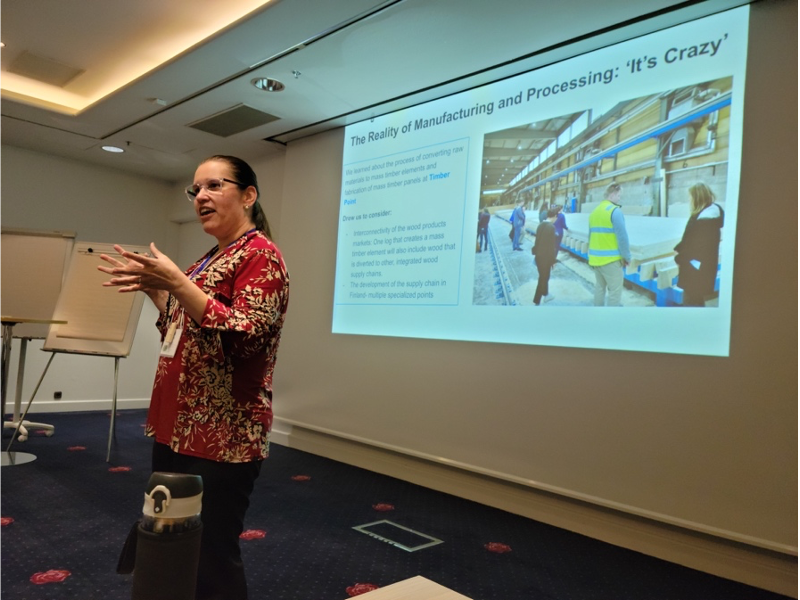
Co-Chair Ana Bastos (URBEM) facilitates dialogue to identify key challenges, questions, and opportunities from site visits. Photo credit: Samuli Skantsi.
TFD identified this intersection as an opportunity to understand the holistic connection between climate, the role of forests and forest products, and the bioeconomy as it relates to wood construction, biodiversity, and carbon sequestration. Gary Dunning ’96 MF, executive director of TFD and TFS, helped forge a partnership between TFD, with its facilitation expertise, and CSFEP, a collaborative initiative “working with system actors to develop a vision for the forest value chain.” Together they created a vision and organized a forum for stakeholders identify and work through these key fracture lines.
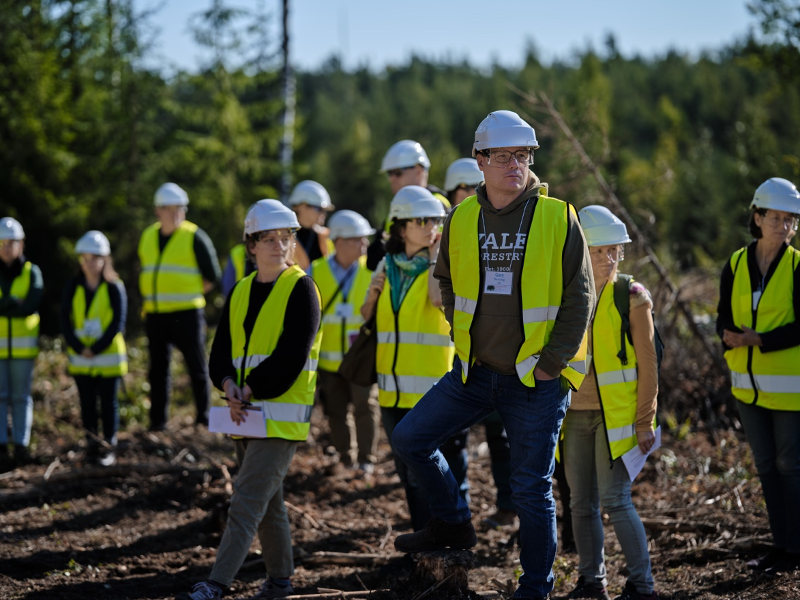
TFD Associate Director Liz Felker ’19 MESc (center left) and Executive Director Gary Dunning ’96 MF (center right) visit a production forest in the Kouvola region during site visit day 1 of the Finland dialogue. Photo credit: Samuli Skantsi.
“How do we create a synergy and a symbiosis rather than creating more burdens on natural habitats and resources?” New Haven architect, faculty member of the Yale School of Architecture, and dialogue participant Alan Organschi posed when reflecting on the trip to Finland. TFD’s work queues up that conversation by bringing together practitioners from points along the entire mass timber supply chain—from forests and land use, to raw materials processing and manufacturing, to design construction and the built environment, and finally into policy and strategy to share their varying areas of expertise and perspectives. “Learning about the needs and concerns of all players in the mass timber value chain is a prerequisite for implementing the widespread and responsible use of this high-value wood product,” Barbara Reck, member of the field dialogue advisory group and senior research scientist at YSE wrote. And this is where the dialogue comes in.
How does increased demand for timber in construction influence forest management and, ultimately, affect the overall health of forests? Is there a risk that we may be overemphasizing wood’s carbon storage capabilities? And given the urgency with which we must act to address climate change, should practitioners begin to act immediately or take a more precautionary approach until there has been more research? What are some potential unintended consequences on forests and rural populations?
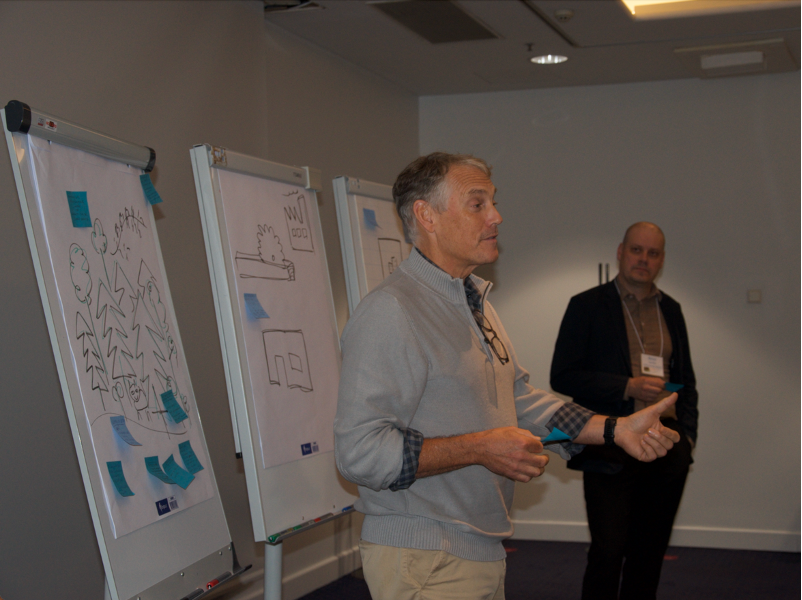
Alan Organschi in the dialogue room helps identify key challenges, questions, and opportunities from site visits. Photo credit: Samuli Skantsi.
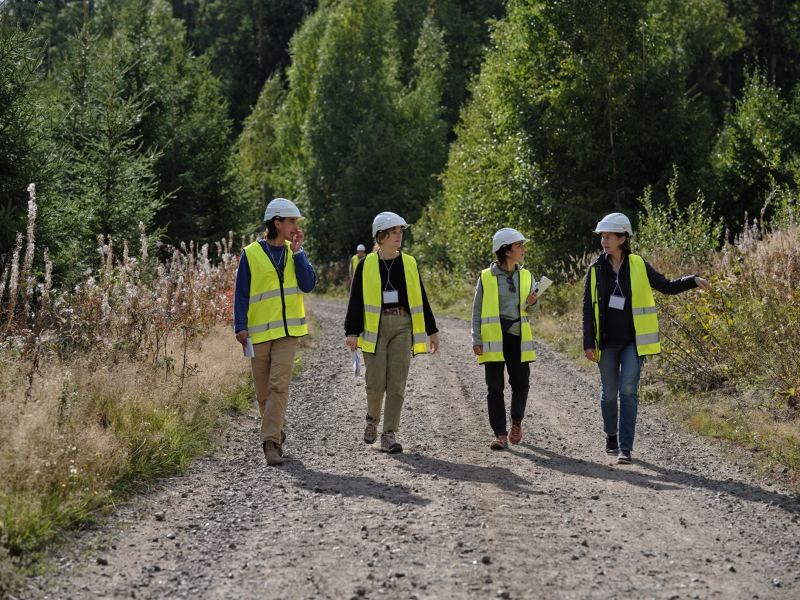
Left to right: TFD Senior Associate Luca Guadagno ’21 MESc, TFD Associate Director Liz Felker ’19 MESc, TFD Associate Ismini Ethridge ’23 MEM, and YSE Senior Research Scientist Barbara Reck visit a production forest in the Kouvola region during site visit day 1. Photo credit: Samuli Skantsi.
The field dialogue was split into two days of field visits to forest sites and mass timber manufacturing and wood construction sites, followed by two days of intensive dialogue digging deeper into forest management, raw materials, processing, manufacturing, design, construction and the built environment. However, in typical TFD fashion, the agenda shifted with a fluidity representative of the group’s interests to ensure the meetings were useful and meaningful for participants. “You can’t be rigid, you can’t be straight-jacketed,” reflected visiting doctoral student Israel Adeseko, who observed the dialogue. The agenda evolved to focus on finalizing identified challenges on the first discussion day so the second day could be freed up to talk about solutions—a testament to TFD’s process of using structured, multi-stakeholder discussion to identify solutions for collective change.
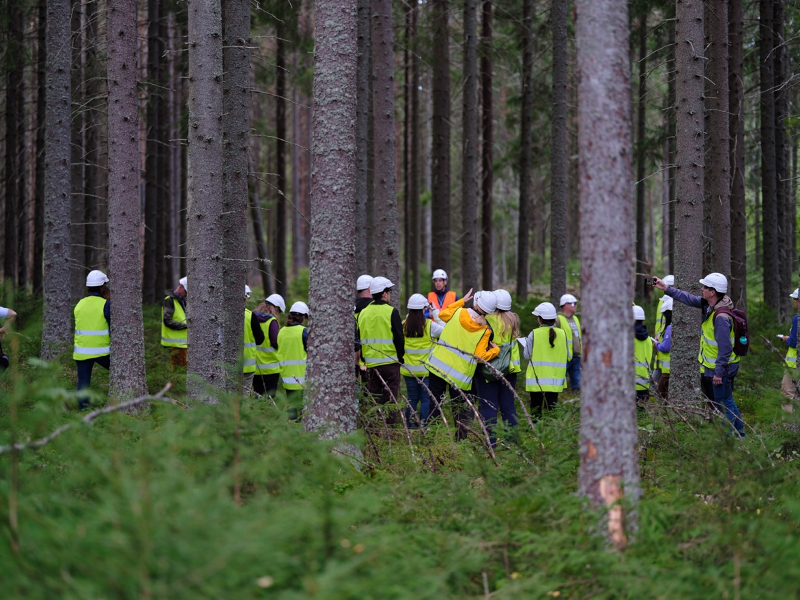
Dialogue participants visit a conservation forest to consider government policies and forest conservation efforts in the region during site visit day 1. Photo credit: Samuli Skantsi.
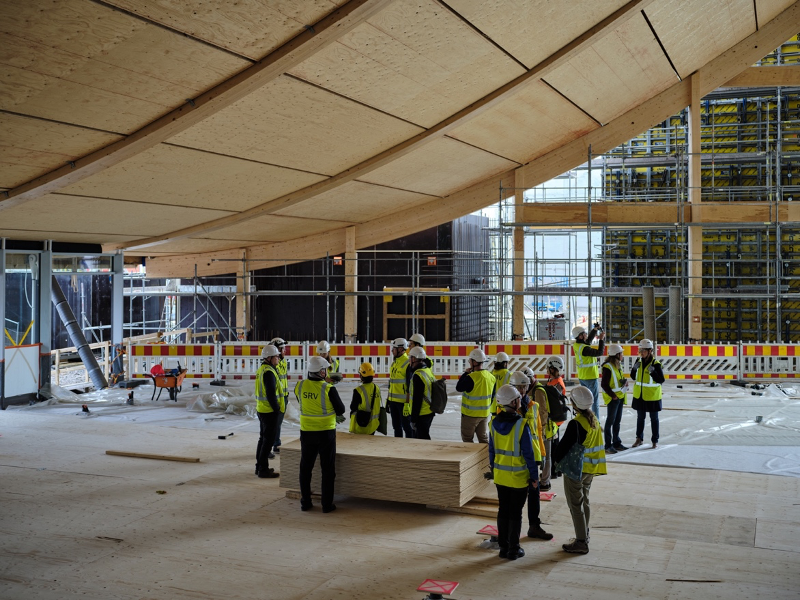
Dialogue participants at the Satama Arena construction site observe how wood components are utilized in construction during site visit day 2. Photo credit: Samuli Skantsi.
Finland, a country with some of the best forest management practices in the world and a pioneer in mass timber construction, provided a paragon for these stakeholders to come together and learn in the field. But forest management—let alone supply chains and policy—is locally-specific, so participants were challenged to compare practices in Finland with parts of the world with lesser oversight, which is why TFD will continue these dialogues in other regions.
So, what’s next? The dialogue has been crucial to breaking down siloed thinking and understanding different perspectives, but what action will come of this convergence of thoughts and ideas? How will the participants apply their learnings to new contexts? “When we think about actions and outcomes that we want, one is a community of engaged stakeholders who can eventually agree to work together outside of TFD’s framework,” TFD Senior Program Associate Luca Guadagno ’21 MESc shared. Partnerships and collaborations are already underway to draw together the diversity of expertise and create true systematic change in the wood products realm. Organschi champions the idea of creating signature pilot projects that look at the entire system from source to implementation and tracking them to avoid doing further damage to forests—a task that requires experts along the entire supply chain. The goal is not just sustainable, but regenerative. “There isn’t a person in that room who I wouldn’t lean on, and haven’t leaned on already, and I think The Forests Dialogue really reinforced those relationships in a great way,” he concluded. “We can solve this, but it’s going to take a new kind of ingenuity—an ingenuity that was on display in Helsinki, but we have to look beyond the forest. We need to use systems thinking and a destruction of siloed walls.”
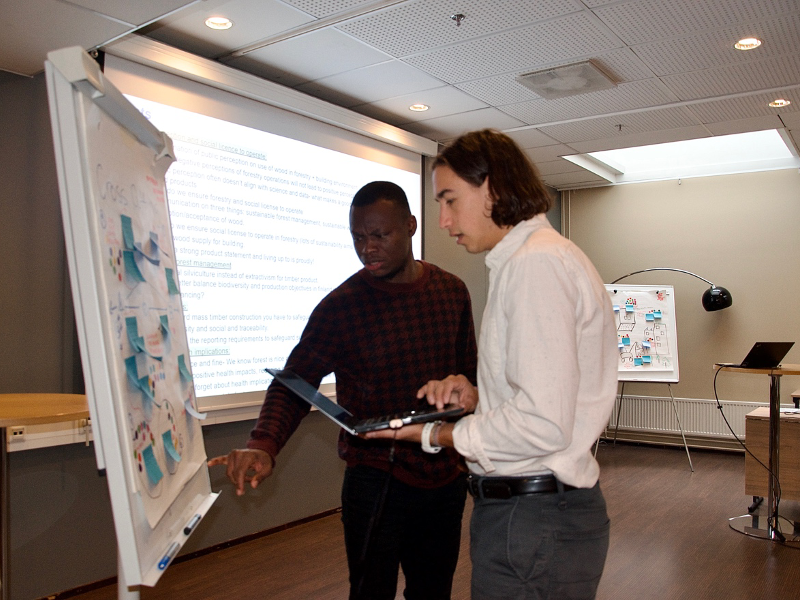
Visiting doctoral student Israel Adeseko and Luca Guadagno ’21 MESc in the dialogue room discussing key challenges, questions, and opportunities from site visits. Photo credit: Ismini Ethridge.
TFD has committed to organizing a follow-up Zoom call for interested participants to see how implementation is progressing in the coming months to explore more directly how to make specific progress on some of the key challenges that were identified during the dialogue. TFD will also publish a Co-Chair’s summary highlighting the discussions and key points of action to share learnings with those not in attendance.
References:
Climate Smart Forest Economy Program. (n.d.). About us | CSFEP. About Us. Retrieved November 4, 2022, from https://www.csfep.org/about-us
Concept Note. The Forests Dialogue, Field Dialogue on Climate Positive Forest Products, Mass Timber. 12—15 September 2020 – Porvoo & Helsinki, Finland.
Santiago, S. (2021, May 13). The Forests Dialogue Scopes Climate Positive Forest Products (CPFPs). The Forests Dialogue. Retrieved September 29, 2022, from https://theforestsdialogue.org/news/forests-dialogue-scopes-climate-posi…
The Forests Dialogue. 2022. Current State of Mass Timber and Wood Product Value Chains in Europe: Background Paper Prepared for TFD’s Climate Positive Forest Products Scoping Dialogue in Finland. TFD, New Haven, CT, USA.
